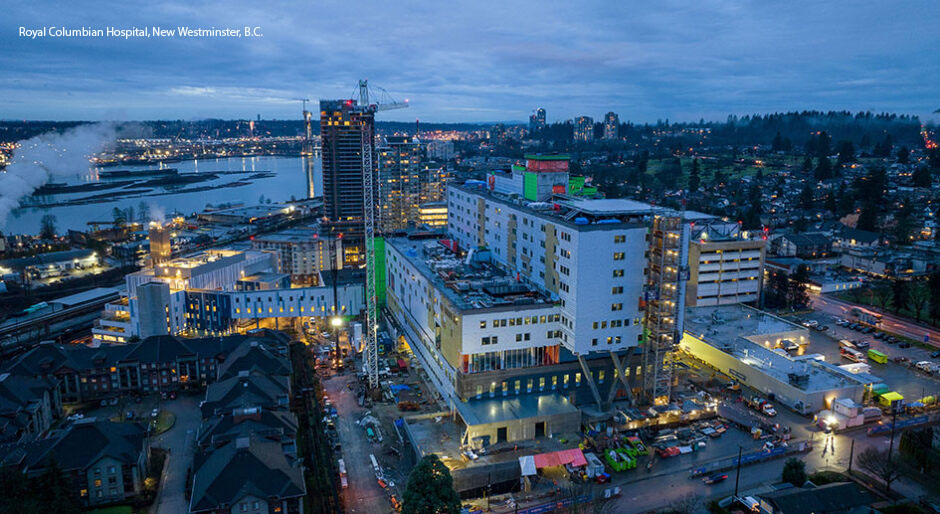Achieving aggressive sustainability goals

Innovation and progress toward sustainability goals require creative thinking and bold action. And an ingrained willingness to test ideas, measure constantly, and adapt helps, too.
EllisDon is embracing those characteristics and working toward ambitious sustainable construction goals, including targeting Gold level certification under the LEEDv4 Healthcare rating system, for its work on the Royal Columbian Hospital (RCH) in New Westminster, B.C. This upgrade project includes constructing a new acute care tower with single occupancy intensive care, medicine, and surgical beds. Also in construction are a modern emergency department, medical imaging facilities, 25 operating theaters, two radiology suites, another CT scanner, dedicated maternity operating rooms, a new main entrance, and a rooftop helipad, all scheduled for completion in 2025.
In this project and others, the organization is piloting several initiatives designed to unlock new ways to achieve higher sustainability goals. And sometimes the positive results come in unexpected ways.
According to environmental manager Daniel Molnar at EllisDon, “Not every new idea merits a pilot project but we’ve been fortunate to implement several new initiatives on the RCH site that have had knock-on positive effects we didn’t foresee.”
Waste Management
As the building’s exterior approaches completion, the RCH initiative stands as a testament to efficient waste management strategies and meticulous source-separation efforts. By focusing on four specific material streams—concrete, steel, wood/cardboard, and gypsum—EllisDon and project teams have successfully diverted 22,441 metric tons of material, achieving an impressive 93 per cent diversion rate and surpassing the original goal of 75 per cent.
Reduce, Reuse, Recycle
RCH is collaborating with the insulation company Rockwool on an exciting pilot program for an Insulation Take-Back Program (RockCycle), intended to collect and return stone wool insulation off-cuts or discards to reprocess into new material and circumvent the landfill altogether.
What EllisDon managers couldn’t entirely quantify while planning the pilot was how well subcontractors would adopt and adhere to the process. Exceeding expectations, the subs not only collected and returned off-cuts but many proactively used the collection bins to source suitable off-cuts that fit other uses further reducing the environmental impacts and materials cost.
Additionally, to promote sustainability and creativity in line with the theme of Canadian Environmental Week in summer of 2023, EllisDon collected and recycled more than 500 used hard hats from employees across Canada while distributing new, safer models as part of its enhanced Safety Program.
“We prevented these hard hats from ending up in landfills by removing the inner baskets and recycling the high-density polyethylene outer shell into pellets for use in new products,” said Molnar. This initiative not only diverted materials from landfills but also supported local art initiatives and sparked conversations about environmental issues. Leeroy New, a Filipino visual artist, repurposed about half of the initial collection into a mixed-media installation. After the exhibit, the hard hats were recycled.
Inroads to NetZero
EllisDon also achieved a significant reduction (well above the original baseline estimates) of greenhouse gas (GHG) emissions from ready-mix concrete for RCH without increasing cost. In collaboration with consultant partners (Bush, Bohlman & Partners, and Ocean Concrete), and with guidance from its internal Sustainable Building Solutions and Building Material Science divisions, concrete mixes were optimized to reduce GHG emissions, while still keeping schedule impacts and contract requirements in consideration. Early calculations showed a reduction of 3,300 metric tons of CO2e—compared to the industry average per mix as identified in CRMCA’s Industry-Wide Environmental Product Declaration—without impacting performance or expense.
Overall, by prioritizing these efforts, emissions savings were equal to 12 million km driven in the average passenger vehicle.
Measuring And Optimizing
Setting aggressive sustainability goals and testing new pilot projects are only as good as the methods for monitoring, adjusting, and reporting on the progress. As Molnar knows from experience, not every pilot project goes as planned, so measuring success is a critical function that should be consistently addressed during the project to avoid missed opportunities and avoid surprises after completion.
There are a number of ways to collect and track the right metrics; the important factor is finding one that works across all the teams and requires the least amount of data entry. On the RCH project, EllisDon has for the first time in B.C., implemented Green Badger’s online sustainability dashboard tools.
The RCH team benefits from the capability to progressively fill out various LEED construction documents online collaboratively and watch the metrics change. As Molnar put it, “This advantage quickly became apparent as we’ve easily shared our tracking progress with clients and consultants at any given moment with the click of a button. The real magic will shine at the final stage of the project when our team can simply click ‘export’ to prepare all the necessary documentation in the CaGBC calculator format for the LEED auditors’ final assessment.”
The process previously required considerable effort and steps on past projects, and the new method will contribute to saved time and resources at RCH’s completion since most of the intensive input and cataloging work will have been automated or pre-emptively handled.
The post Achieving aggressive sustainability goals appeared first on REMINET.

